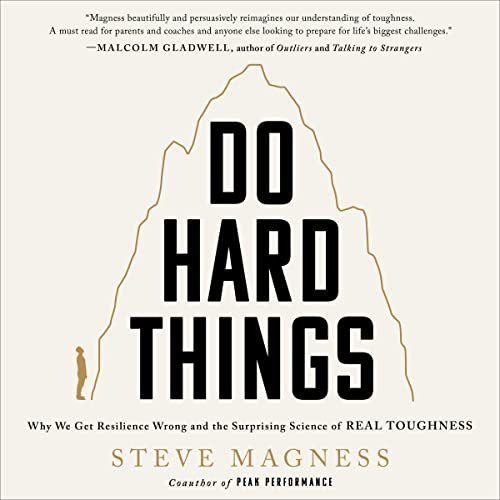Do Hard Things: Why We Get Resilience Wrong and the Surprising Science of Real Toughness

Physical Copy:
Audiobook:
By: Steve Magness
Rating: B
In an effort to distract myself from being tough while training, I listened to another book about doing hard things. Actually the title was “Do Hard Things”. Fitting.
The book was broken up into 4 lessons about toughness with stories and examples to drive each of them home.
- Lesson 1: Ditch the Facade, Embrace Reality
- Lesson 2: Listen to Your Body
- Lesson 3: Respond Instead of React
- Lesson 4: Transcend Discomfort
The one that stood out to me the most was Lesson 1: Ditch the Facade, Embrace Reality.
When we think of tough people, we think of professional fighters or football players. Guys that get hit hard, laugh it off, and scream right back in the face of their opponents.
I think of Conor McGregor getting in his opponent’s face before a fight and getting in their head.
I think of bull riders riding half a season with their jaw wired shut and a cast on their forearm. Body be damned, their mind is focused on the task.
But is that what I want to teach my boys?
Is that “toughness” worth modeling?
The author would argue that it isn’t. He would argue our tough coaches of childhood that made us do difficult tasks for the sake of doing difficult things were misguided.
The real lesson is to teach problem solving and perseverance. Doing hard things should have a purpose aside from just doing hard things. It could be getting physically fit, completing a degree, or any other worthwhile purpose.
What do I want to teach my boys?
Commitment leads to Courage. Courage leads to Capability. Capability leads to Confidence.
- Have the courage to try new things. Things you are bad at. Difficult worthwhile things. Fail often.
- Use your brain to solve problems. When they fail, do not swoop in and save them. Don’t make a big deal out of it. Rather, walk beside them and talk about it. What went wrong? What can we work on? Help them facilitate creatively solving their own problems.
- Develop Perseverance. Perseverance is a super power. By doing what you say you will over and over, you will build a powerful mental muscle, true self-confidence, and many capabilities.
- True Confidence is Quiet; Insecurity is Loud. You can’t have confidence until you have experience. No matter the task, whether it be sports, dating, public speaking, or career. You need experience before you can have confidence. Those that yell loudest about their confidence are usually faking it or exaggerating their experience to fool you and themselves. True confidence is calm, experienced, and discerning.
- Know When to Hold ‘Em and When to Fold ‘Em. We do hard things to solve meaningful problems or to become a person capable of solving meaningful problems. Once you have given something the proper perseverance and it is no longer capable of solving the problem at hand or preparing you to solve future problems, move on. There are times when perseverance should appear reckless (i.e.the bull rider with the broken arm still running his hand in his rope). But when the effort no longer has the potential to yield the desired result, you should change paths. There is peace and clarity when you have given something your full effort and can move on knowing that it is no longer capable of solving that problem for you.
Conclusion
Real toughness isn’t the loud mouth fighter. Real toughness is resilient, calm, experienced, and discerning. It takes both wisdom and risk to develop. Our world needs more toughness now than ever before. We have to be intentional in developing it within ourselves and those that come after us.
